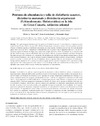Please use this identifier to cite or link to this item:
https://accedacris.ulpgc.es/handle/10553/49582
| Title: | Abundance and size patterns of Holothuria sanctori, Holothuria mammata and Holothuria arguinensis (Echinodermata: Holoturoidea) off Gran Canaria Island, eastern Atlantic | Other Titles: | Patrones de abundancia y talla de Holothuria sanctori, Holothuria mammata y Holothuria arguinensis (Echinodermata: Holoturoidea) en la isla de Gran Canaria, Atlántico oriental | Authors: | Navarro, Pable G. García-Sanz, Sara Tuya, Fernando |
UNESCO Clasification: | 240119 Zoología marina 250501 Biogeografía |
Keywords: | Rugosity Sea cucumber Beche de mer Canary Islands Atlantic Ocean, et al |
Issue Date: | 2013 | Publisher: | 0717-3326 | Journal: | Revista de Biologia Marina y Oceanografia | Abstract: | The spatio-temporal abundance and size patterns of Holothuria sanctori, H. mammata and H. arguinensis were studied from February 2009 to January 2010, off Gran Canaria Island. Holothuria sanctori coloration patterns and the influence of bottom rugosity on holothurian abundances were also studied. Holothuria sanctori was the most abundant species with 1.13 ± 0.29 ind m-2, followed by H. mammata with 0.16 ± 0.22 ind m-2 and H. arguinensis with 0.04 ± 0.05 ind m-2. Holothuria arguinensis showed the bigger sizes, with a mean length of 255.07 ± 55.49 mm, followed by H. mammata with 234.29 ± 45.10 mm and H. sanctori with 181.35 ± 29.15 mm. Only 9 <100 mm H. sanctori individuals were found throughout the study, and none of H. mammata or H. arguinensis. The abundance and size did not vary between annual seasons, except small punctual fluctuations. The 3 species showed consistent temporal abundance patterns among locations. Holothuria sanctori coloration is related with the size of individuals. Bottom rugosity influences the abundance of holothurians, having maximum abundances of H. sanctori on medium rugosity bottoms and of H. mammata and H. arguinensis on high rugosity areas. This study represents a clear advance in our knowledge of the class Holothuroidea in Canary Islands, and highlights some aspects which structure holothurian populations in rocky bottoms. Se estudiaron los patrones espacio-temporales de abundancia y talla de Holothuria sanctori, H. mammata y H. arguinensis desde febrero de 2009 a enero de 2010 en la isla de Gran Canaria. Se estudió también si la coloración de H. sanctori variaba con la talla de los individuos y si la rugosidad del sustrato influía sobre la abundancia de holoturias en el mismo. Holothuria sanctori fue la especie más abundante con 1,13 ± 0,29 ind m-2, seguida de H. mammata con 0,16 ± 0,22 ind m-2 y de H. arguinensis con 0,04 ± 0,05 ind m-2. La especie que presentó mayor talla fue H. arguinensis, con una talla media de 255,07 ± 55,49 mm seguida de H. mammata con 234,29 ± 45,10 mm y de H. sanctori con 181,35 ± 29,15 mm. Solo se encontraron 9 individuos <100 mm de H. sanctori y ninguno de H. mammata o H. arguinensis. La abundancia y la estructura de tallas no variaron entre estaciones anuales, salvo pequeñas fluctuaciones puntuales. Entre localidades, las 3 especies presentaron patrones de abundancia temporales consistentes. La coloración de H. sanctori está relacionada con la talla de los individuos. La rugosidad del sustrato influye en la abundancia de holoturias, observándose las máximas abundancias de H. sanctori con rugosidades medias del sustrato y de H. mammata y H. arguinensis con altas. Este trabajo es un avance en el conocimiento de la clase Holothuroidea en Canarias principalmente sobre los aspectos que estructuran las poblaciones de holoturias en fondos rocosos. |
URI: | https://accedacris.ulpgc.es/handle/10553/49582 | ISSN: | 0717-3326 | DOI: | 10.4067/S0718-19572013000200007 | Source: | Revista de Biologia Marina y Oceanografia [ISSN 0717-3326], v. 48, p. 273-284 |
| Appears in Collections: | Artículos |
SCOPUSTM
Citations
21
checked on Jun 8, 2025
WEB OF SCIENCETM
Citations
18
checked on Jun 8, 2025
Page view(s)
39
checked on Nov 5, 2022
Download(s)
57
checked on Nov 5, 2022
Google ScholarTM
Check
Altmetric
Share
Export metadata
Items in accedaCRIS are protected by copyright, with all rights reserved, unless otherwise indicated.
